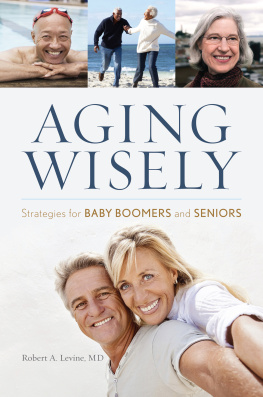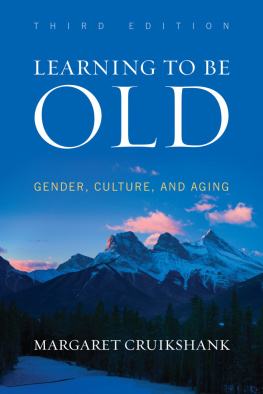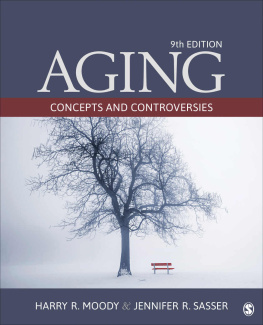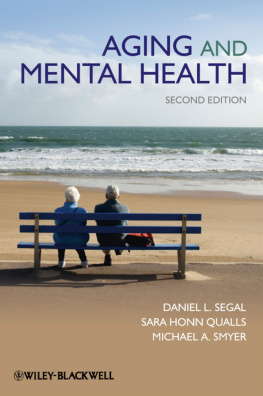Table of Contents
Page List
Guide



Health Professions Press, Inc.
Post Office Box 10624
Baltimore, Maryland 21285-0624
www.healthpropress.com
Copyright 2015 by Health Professions Press, Inc.
All rights reserved.
Interior and cover designs by Mindy Dunn.
Typeset by Barton Matheson Willse & Worthington, Baltimore, Maryland.
Manufactured in the United States of America by Versa Press, East Peoria, Illinois.
Library of Congress Cataloging-in-Publication Data
Golant, Stephen M., author.
Aging in the right place / by Stephen M. Golant.
p. ; cm.
Includes bibliographical references and index.
ISBN 978-1-938870-33-0 (pbk.)
I. Title.
[DNLM: 1. Aged. 2. Homes for the Aged. 3. Housing for the Elderly. 4. Quality of Life. 5. Social Environment. WT 30]
RA564.8
362.16dc23
2014045378
British Library Cataloguing in Publication data are available from the British Library.
E-book edition: ISBN 978-1-938870-36-1
I dedicate this book to my granddaughter, Ella
C ONTENTS
A BOUT THE A UTHOR
Stephen M. Golant, Ph.D., is professor at the University of Florida (Gainesville) and previously was associate professor at the University of Chicago. He has been conducting research on the housing, mobility, transportation, and long-term care needs of older adult populations for most of his academic career.
Dr. Golant is a Fellow of the Gerontological Society of America and a Fulbright Senior Scholar award recipient. In 2012, he received the Richard M. Kalish award from the Gerontological Society of America in recognition of his insightful and innovative publications on aging and life development in the behavioral and social sciences. Print and Web-based media have often featured his research and ideas and he has appeared on numerous television and radio programs, including ABCs national news program 20/20.
Dr. Golant has written or edited more than 140 papers and books, including Location and Environment of Elderly Populations (Wiley, 1979); A Place to Grow Old: The Meaning of Environment in Old Age (Columbia University Press, 1984); Housing Americas Elderly: Many Possibilities, Few Choices (Sage Publications, 1992); The Columbia Retirement Handbook (Columbia University Press, 1994); Encyclopedia of Financial Gerontology (Greenwood Press, 1996); the CASERA Report (Creating Affordable and Supportive Elder Renter Alternatives) (Margaret Lynn Duggar & Associates, Inc., 1999); and The Assisted Living Residence: A Vision for the Future (The Johns Hopkins University Press, 2008).
Dr. Golant serves on the editorial boards of The Gerontologist, Journal of Aging Studies, CSA Journal (Society of Certified Senior Advisors), Journal of Housing for the Elderly, Research on Aging, and Seniors Housing & Care Journal.
Dr. Golant is frequently called on by corporations, universities, state government agencies, and national organizations as a lecturer or an adviser. He also served as a consultant to the Congressionally appointed Commission on Affordable Housing and Health Facility Needs for Seniors in the 21st Century (Seniors Commission), a bipartisan 14-member panel created by an act of Congress to study the housing and healthcare needs for the next generation of elderly Americans and to offer specific policy and legislative recommendations to the U.S. House of Representatives and the U.S. Senate.
A CKNOWLEDGMENTS
It took me longer to write this book than I had originally planned, undoubtedly because it incorporated many years of material from my research and writing on the housing and care arrangements of older Americansespecially as seen through their idiosyncratic eyes. I was also slowed by my quest to convince readers that there is no one prescription for aging successfullydespite what the experts claimand that whatever the life course pathways of aging adults, the places they occupy during their old age do matter.
I am grateful to the many individuals who helped make this effort possible. Most importantly, my wife, Dora, steadfastly supported me as I labored over the manuscript. My daughter, Alexandra, reminded me that the meaning of life rested on far more than just another published book. My sister, Annette, continually cheered me on through my writing efforts. My good friend and colleague, Jay Gubrium, has been an invaluable academic sounding board throughout my career and has always offered good counsel with humor and honesty over many a glass of wine.
This book would not have reached fruition, however, if not for the persistence and support of Mary Magnus, Director of Publications for Health Professions Press, and her confidence in this effort. I also benefitted greatly from working with her highly professional staff, who helped move this book from an overly long manuscript to a succinctly written book. Special thanks to Teresa Ingraham Iafolla, who contributed mightily to the effort of shortening my original manuscript. Kudos to Cecilia Gonzlez, who skillfully and cheerfully managed the copyediting, typesetting, proofreading, and indexing of my manuscript and tolerated my countless queries. Only authors will appreciate how important a publishers production manager is to the final book product. I am also much appreciative of the marketing and promotional efforts of Kaitlin Konecke.
It is unquestionably a humbling exercise to conduct ones own life review and remember the mentors and colleagues who played critical roles in your own intellectual growth. The most important of these valued individuals to whom I owe a debt of gratitude, and the universities where our lives originally crossed, include Larry Bourne, Jim Simmons, Alan Baker, and Ian Burton at the University of Toronto; Dick Morrill and Arthur Farber at the University of Washington; and Brian Berry, Bernice Neugarten, Morton Lieberman, Bert Cohler, Mike Czikszentmihalyi, and Sheldon Tobin at the University of Chicago.
P REFACE
What makes us happy in old age? Throughout my academic career, I believed that studying the personalities or demographics of older people (e.g., their financial means, race, ethnicity, marital status, gender) offered only an incomplete explanation. It was also insufficient just to focus on the declines in their physical and mental prowess. Although important factors, there was another body of knowledge to tap. I had to know how the residential and care settings occupied and used by older people impacted their physical and mental well-being. Did their homes, neighborhoods, and communities or their tailor-made senior housing alternatives and long-term care services and supports offer them opportunities to more fully enjoy their lives, feel better about themselves, and enable them to access quality assistance to cope with their aging bodies? What were the upsides and downsides of these options? How did where they live matter for their happiness?
I also recognized that although academics and professionals must assess the quality of older peoples residential and care environments, their detached and scientific judgments were not enough. We had to get into the heads of older people to fully appreciate whether their places of residence influenced their well-being. This was the impetus for my theoretical model showing that when older people find their right places to live, they have achieved










